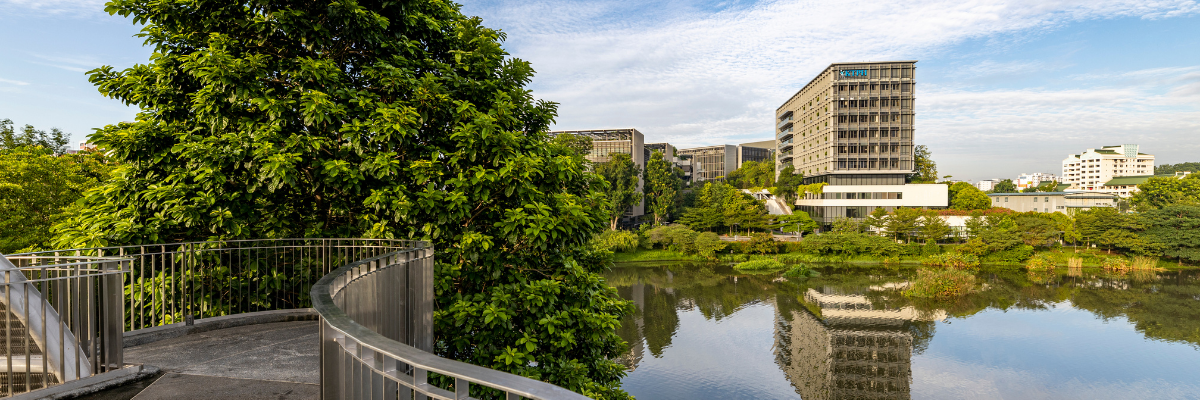
Speak about buildings being green, and chances are images of renewable energy, carbon-neutrality and net-zero energy use come to mind. However, as previously pointed out, do such commonly found ‘green’ and ‘eco-conscious’ elements really bring people closer to the natural environment?
At CPG Corporation, one of the key philosophies that our architects, engineers, facility managers, project managers and construction managers hold is to develop buildings and spaces that re-cultivate in people a love for nature.
To achieve that, we actively implement and incorporate biophilic designs that go beyond mere addition of greenery to fully utilising and amplifying the surrounding light, wind, water, and flora and fauna for the benefit and wellness of building occupants.
Benefits of Biophilic Design
- Studies have enumerated the many positive effects of having buildings that incorporate biophilic design.
- In the workplace, biophilic design is known to increase employees’ cognitive performance, concentration, work productivity, motivation and feelings of safety.
- Have to spend time in a hospital? Hospitals designed to maximise patients’ exposure to natural daylight and greenery, saw patients feeling calmer, more balanced and requiring less pain medication.
- Biophilic design is also vital in education settings. Not only could students and teachers treat school buildings themselves as outdoor science laboratories and classrooms, they are simultaneously stimulated by the environment to achieve heightened attentions and lifted spirits.
Ar. Jerry Ong: On a personal level, I honestly believe the Biophilic Design approach should be intuitive for architects, engineers, facility managers and even developers in their projects, and is not something that is added as an afterthought. So the implementation of biophilic design can only work if the architect/engineer first truly believes in it. The next step then is to persuade clients of the various benefits of biophilic design so that the overall vision is aligned.
Ar. Tan Shao Yen: Any success in the implementation of biophilic design will require establishing a shared vision among all stakeholders, including clients, architects, engineers, users and facilities managers. They must all see value in connecting building occupants with natural elements and living things, and agree on how the provisions for natural elements and living things can be designed, built and maintained.
Ar. Patrick Tan: Biophilic Design should happen early in the design process, before concepts and forms are set. A deep understanding of sites’ contexts, including histories, cultures, ecologies and climates, are essential in creating biophilic buildings. Engaging experts and stakeholders ahead of time allows teams to sufficiently incorporate any information, visions and objectives of projects with regards to any biophilic goals.
Architects/engineers might want to consider the following questions in their exploration of Biophilic Design:
Place Context
- What is the area’s material palette?
- How do occupants respond to both climate and weather?
- How does the eco-system work?
- How can people be connected to the climate and ecosystem of this place?
People/Culture Context
- How can a community be created in this place?
- What are the cultural strengths of the place?
- How can building occupants be connected to nature from arrival to departure?
- What are the journeys and interactions with nature for the occupants?
- What are the relevant historical and/or cultural influences, and their implications to the space?
Project Context
- What are the key areas for flexibility or responsiveness to climate, weather or occupants?
- How will the aesthetics of the project contrast and/or reflect the existing context?
- How can the project’s original goals be supported and enhanced through biophilic design?
Ar. Kuan Chee Yung: To summarise, the first step to implementing biophilic design is to be concerned about how people interact with the existing ecosystem and natural capital of the land via our designs. This means to physically, programmatically and aesthetically connect with the site’s natural features. If the development’s brief ultimately clashes with the systems, we can either bridge over or even re-create or regenerate the original systems. For sites that are already barren or disturbed, we look further at the urban level to pull in and connect with natural green and blue systems. This requires a good understanding about integrated naturescape designs and a sensitivity to natural aesthetic patterns. Our guiding principle is to never design nature into unconnected pockets, and make circulation networks green so that nature extends out and is not confined in. Once the first step is completed, we then ‘Bring Outside In and Inside Out’ by keeping the design plans porous, allowing in daylight, ventilation and views.
Ar. Jerry Ong: Firstly, I hope with more public appreciation of the benefits of Biophilic Design, there will be more motivation from all levels of the industry to adopt a Biophilic Design approach in even more projects so as to make Singapore a truly Biophilic City. To this end, perhaps there could be even more governmental guidelines introduced to actively encourage the incorporation of biophilic elements in the built environment.
Ar. Patrick Tan: Biophilic design is about connecting people to nature. Keeping this objective in mind will help us stay focused on strategies and engage the building form, materials, and spatial and psychological responses, rather than it being simply a landscape exercise, or inserting a few green walls or providing natural light. With an integrated design that includes a biophilic design agenda, we are not trying to create a green building but rather a building that heals the ecosystem that we are placing the building in. It turns into a relationship between mankind, their constructs and the environment.
Ar. Tan Shao Yen: I believe Biophilic Design is an important building block towards the notion of Regenerative Design. Regenerative processes ultimately restore, renew, or reproduce energy, resources, or materials. A cluster of regenerative designed buildings would be able to regenerate the energy, water, food, and other resources that the buildings themselves consumed, or even trade and exchange resources with others or with the wider natural environment. This idea can be seen in the natural ecosystems, in which organic and inorganic materials are metabolised (used) and metamorphosed (changed) into other essential materials within a closed system. In this regard, regenerative built environments not only avoid degrading the environment, but actually forms part of the environmental ecosystem. That is an ideal world but advancement in various knowledge fields, such as systems thinking, biomimicry, circular economy, agriculture 4.0, etc., gives me optimism that we are converging towards that direction.
Ar. Kuan Chee Yung: We are now designing various biotic structures in which nature can actually grow on top of and as part of our designs. We have also studied various ‘Green Heart’ solutions, where the landscape is part of interior spaces. We are further integrating ‘Urban Farming’ and ‘Urban Forest’ solutions into our Biotic Designs so that integrated naturescapes are not only for food/foraging purposes but also for bio-diversity. At urban levels, we are integrating Biophilic Design into Active Mobility Networks/ future drone and drone transport paths. We have gone beyond Singapore’s Active, Beautiful and Clean (ABC) programme to studying bio-indicator designs for pollution and even forest bathing (Shinrin-Yoku) for wellness. We are studying re-forestation and timescapes where designs are allowed to grow and develop natural complexity over time. We are also studying indigenous planting, micro and macro organism reintroduction plus reusing inert waste to form a new habitat stratum. All of these are on the cutting-edge of natural capital knowledge, which we hope will re-establish planet Earth and counter habitat loss and climate change.
Maintainability
To end off, even as we embark on an active incorporation of biophilic design in our built environment, it is nevertheless important to keep in mind the need for our buildings and spaces to be easily maintainable. Buildings should not, for the mere sake of including biophilic elements, possess structures that unnecessarily add on or hamper for instance, maintenance staff in their daily servicing activities. So architects and engineers need to seek a balance between incorporating biophilic design and keeping the built environment maintainable.
This article was authored by:
Ar. Tan Shao Yen, Group Chief Innovation Officer
CPG Corporation
tan.shao.yen@cpgcorp.com.sg
Ar. Kuan Chee Yung, Director & Senior Vice President
CPG Signature Pte. Ltd.
kuan.chee.yung@cpgcorp.com.sg
Ar. Jerry Ong, Senior Vice President
Architecture Group, CPG Consultants Pte. Ltd
jerry.ong@cpgcorp.com.sg
Ar. patrick Tan, Senior Vice President
Architecture Group, CPG Consultants Pte. Ltd
patrick.tan@cpgcorp.com.sg


